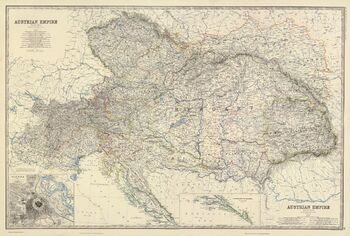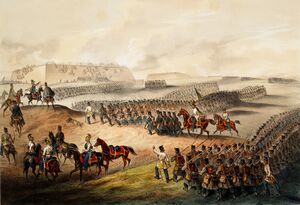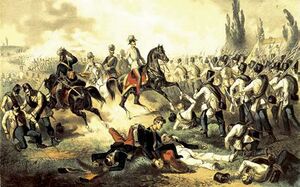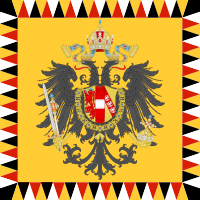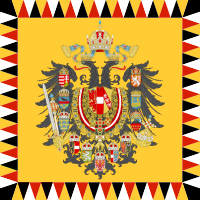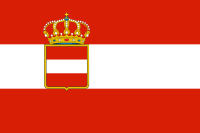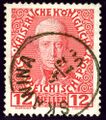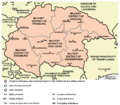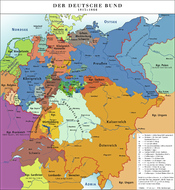الإمبراطورية النمساوية
الامبراطورية النمساوية (ألمانية: Kaisertum Österreich) كانت امبراطورية لاحقة في العصر الحديث تأسست على بقايا الامبراطورية الرومانية المقدسة متمركزة حول ما هو اليوم النمسا ، وقد استمرت من 1804 حتى 1867. قد أعقبتها النمسا-المجر, which was proclaimed after declaring the Emperor of Austria also King of Hungary, a diplomatic move that elevated Hungary's status within the Austrian Empire as a result of the Austro-Hungarian Compromise of 1867. The Austro-Hungarian Empire (1867 to 1918) was itself dissolved by the victors at the end of الحرب العالمية الأولى and broken into separate new states.
المصطلح "الامبراطورية النمساوية" is also used for the Habsburg possessions before 1804, which had no official collective name, although Austria is more frequent; the term of النمسا-المجر has also been used, incorrectly.
The Austrian Empire was founded by the Habsburg monarch الامبراطور الروماني فرانسيس الثاني (الذي أصبح فرانسيس الأول من النمسا), as a state comprising his personal lands within and outside of the Holy Roman Empire.
This was a reaction to Napoleon Bonaparte's proclamation of the الامبراطورية الفرنسية الأولى in 1804.
. . . . . . . . . . . . . . . . . . . . . . . . . . . . . . . . . . . . . . . . . . . . . . . . . . . . . . . . . . . . . . . . . . . . . . . . . . . . . . . . . . . . . . . . . . . . . . . . . . . . . . . . . . . . . . . . . . . . . . . . . . . . . . . . . . . . . . . . . . . . . . . . . . . . . . . . . . . . . . . . . . . . . . . .
التاريخ
التأسيس
Changes shaping the nature of the Holy Roman Empire took place during conferences in Rastatt (1797–1799) and Regensburg (1801–1803). On 24 March 1803, the Imperial Recess (ألمانية: Reichsdeputationshauptschluss) was declared, which reduced the number of ecclesiastical states from 81 to only 3 and the free imperial cities from 51 to 6. This measure was aimed at replacing the old constitution of the Holy Roman Empire, but the actual consequence of the Imperial Recess was the end of the empire. Taking this significant change into consideration, the Holy Roman Emperor Francis II created the title Emperor of Austria, for himself and his successors.
عهد مترنيخ
Klemens von Metternich became Foreign Minister in 1809. He also held the post of Chancellor of State from 1821 until 1848, under both Francis I and his son Ferdinand I. The period of 1815–1848 is also referred to as the "Age of Metternich".[2] During this period, Metternich controlled the Habsburg monarchy's foreign policy. He also had a major influence in European politics. He was known for his strong conservative views and approach in politics. Metternich's policies were strongly against revolution and liberalism.[3] In his opinion, liberalism was a form of legalized revolution.[4] Metternich believed that absolute monarchy was the only proper system of government.[2] This notion influenced his anti-revolutionary policy to ensure the continuation of the Habsburg monarchy in Europe. Metternich was a practitioner of balance-of-power diplomacy.[5] His foreign policy aimed to maintain international political equilibrium to preserve the Habsburgs' power and influence in international affairs. Following the Napoleonic Wars, Metternich was the chief architect of the Congress of Vienna in 1815.[5] The Austrian Empire was the main beneficiary from the Congress of Vienna and it established an alliance with Britain, Prussia, and Russia forming the Quadruple Alliance.[3] The Austrian Empire also gained new territories from the Congress of Vienna, and its influence expanded to the north through the German Confederation and also into Italy.[3] Due to the Congress of Vienna in 1815, Austria was the leading member of the German Confederation.[6] Following the Congress, the major European powers agreed to meet and discuss resolutions in the event of future disputes or revolutions. Because of Metternich's main role in the architecture of the Congress, these meetings are also referred to as the "Metternich congress" or "Metternich system". Under Metternich as the Austrian foreign minister, other congresses would meet to resolve European foreign affairs. These included the Congresses of Aix-la-Chapelle (1818), Carlsbad (1819), Troppau (1820), Laibach (1821), and Verona (1822).[2] The Metternich congresses aimed to maintain the political equilibrium among the European powers and prevent revolutionary efforts. These meetings also aimed to resolve foreign issues and disputes without resorting to violence. By means of these meetings and by allying the Austrian Empire with other European powers whose monarchs had a similar interest in preserving conservative political direction, Metternich was able to establish the Austrian Empire's influence on European politics. Also, because Metternich used the fear of revolutions among European powers, which he also shared, he was able to establish security and predominance of the Habsburgs in Europe.[3]
Under Metternich, nationalist revolts in Austrian north Italy and in the German states were forcibly crushed. At home, he pursued a similar policy to suppress revolutionary and liberal ideals. He employed the Carlsbad Decrees of 1819, which used strict censorship of education, press and speech to repress revolutionary and liberal concepts.[2] Metternich also used a wide-ranging spy network to dampen down unrest.
Metternich operated very freely with regard to foreign policy under Emperor Francis I's reign. Francis died in 1835. This date marks the decline of Metternich's influence in the Austrian Empire. Francis' heir was his son Ferdinand I, but he suffered from health issues. Ferdinand's accession preserved the Habsburg dynastic succession, but he was not capable of ruling.[3] The leadership of the Austrian Empire was transferred to a state council composed of Metternich, Francis I's brother Archduke Louis, and Count Franz Anton Kolowrat, who later became the first Minister-President of the Austrian Empire. The liberal Revolutions of 1848 in the Austrian Empire forced Metternich's resignation. Metternich is remembered for his success in maintaining the status quo and the Habsburg influence in international affairs.[2] No Habsburg foreign minister following Metternich held a similar position within the empire for such a long time nor held such a vast influence on European foreign affairs.[3]
Historians often remember the Metternich era as a period of stability: the Austrian Empire fought no wars nor did it undergo any radical internal reforms.[7] However, it was also thought of as a period of economic growth and prosperity in the Austrian Empire.[7] The population of Austria rose to 37.5 million by 1843. Urban expansion also occurred and the population of Vienna reached 400,000. During the Metternich era, the Austrian Empire also maintained a stable economy and reached an almost balanced budget, despite having a major deficit following the Napoleonic Wars.[8]
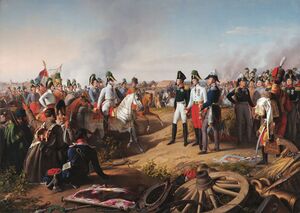
ثورات 1848
From March 1848 through November 1849, the Empire was threatened by revolutionary movements, most of which were of a nationalist character. Besides that, liberal and even socialist currents resisted the empire's longstanding conservatism. Although most of the revolution plans failed, some changes were made; significant lasting reforms included the abolition of serfdom, cancellation of censorship and a promise made by Ferdinand I of Austria said to implement a constitution throughout the whole Empire.
سنوات باخ
After the death of Prince Felix of Schwarzenberg in 1852, the Minister of the Interior Baron Alexander von Bach largely dictated policy in Austria and Hungary. Bach centralized administrative authority for the Austrian Empire, but he also endorsed reactionary policies that reduced freedom of the press and abandoned public trials. He later represented the Absolutist (or Klerikalabsolutist) direction, which culminated in the concordat of August 1855 that gave the Roman Catholic Church control over education and family life. This period in the history of the Austrian Empire would become known as the era of neo-absolutism, or Bach's absolutism.
The pillars of the so-called Bach system (Bachsches System) were, in the words of Adolf Fischhof, four "armies": a standing army of soldiers, a sitting army of office holders, a kneeling army of priests and a fawning army of sneaks.[بحاجة لمصدر] Prisons were full of political prisoners, like Czech nationalist journalist and writer Karel Havlíček Borovský who was forcibly expatriated (1851–1855) to Brixen. This exile undermined Borovský's health and he died soon afterwards. This affair earned Bach a very bad reputation amongst Czechs and subsequently led to the strengthening of the Czech national movement.[بحاجة لمصدر]
However, Bach's relaxed ideological views (apart from the neo-absolutism) led to a great rise in the 1850s of economic freedom. Internal customs duties were abolished, and peasants were emancipated from their feudal obligations.[9]
In her capacity as leader of the German Confederation, Austria participated with volunteers in the First War of Schleswig (1848–1850).[6]
Sardinia allied itself with France for the conquest of Lombardy–Venetia. Austria was defeated in the 1859 armed conflict. The Treaties of Villafranca and Zürich removed Lombardy, except for the part east of the Mincio river, the so-called Mantovano.[10]
بعد 1859
The Constitution of 1861 created a House of Lords (Herrenhaus) and a House of Deputies (Abgeordnetenhaus). But most nationalities of the monarchy remained dissatisfied.
After the second war with Denmark in 1864, Holstein came under Austrian, Schleswig and Lauenburg under Prussian administration. But the internal difficulties continued.[11] Diets replaced the parliament in 17 provinces, the Hungarians pressed for autonomy, and Venetia was attracted by the now unified Italy.
After the Austrian army was defeated in the Austro-Prussian War of 1866 and the German Confederation was dissolved, the Austro-Hungarian Compromise of 1867 was adopted. By this act, the Kingdom of Hungary and the Empire of Austria as two separate entities joined on an equal basis to form the Dual Monarchy of Austria-Hungary. During World War I,
The frequent abbreviation K.u.K. (Kaiserliche und Königliche, "Imperial and Royal") does not refer to that dual monarchy but originated in 1745, when the "royal" part referred to the Apostolic Kingdom of Hungary.[بحاجة لمصدر] However, during World War I Austria-Hungary issued military stamps for use in occupied regions, with the text "K.u.K. Feldpost" or K.u.K. Militärpost.
. . . . . . . . . . . . . . . . . . . . . . . . . . . . . . . . . . . . . . . . . . . . . . . . . . . . . . . . . . . . . . . . . . . . . . . . . . . . . . . . . . . . . . . . . . . . . . . . . . . . . . . . . . . . . . . . . . . . . . . . . . . . . . . . . . . . . . . . . . . . . . . . . . . . . . . . . . . . . . . . . . . . . . . .
الفنـون
انتعش المسرح في فينا على كل مستوياته ابتداء من الاسكتشات التافهة في المسارح التي تقدم أعمالاً مُرتجلة (غير معدَّة سلفاً) إلى الدراما الكلاسية في المسارح الراقية ذوات الديكورات المكلِّفة. وكان أقدم المسارح وأكثرها انتظاماً هو الكيرنتنيرثور Karntnerthor الذي شيدته البلدية في سنة 8071، وفي هذا المسرح وجدنا الكاتب المسرحي جوزيف أنطون سترانيتسكي John Anton Stranitsky (توفي 6271) يبني على شخصية أرليشينو Arlecchino (هارلكن Harlequein) الإيطالية، فيخلق ويطوّر شخصية هانزڤورست Hanswurst أو جون بولوني John Boloney المهرّج الضاحك الصخَّاب الذي هجا الألمان - في الجنوب والشمال - سخافاتهم المحبّبة من خلاله. وفي سنة 6771 دعم جوزيف الثاني وموَّل البيرجثيتر the Burgtheater الذي وعدت واجهته الكلاسية بأفضل المسرحيات الكلاسية والحديثة. وكان أكثر المسارح فخامة وترفا هو مسرح آن دير فين Theater an-der-wien (على نهر فين Wien) الذي شيّده في سنة 3971 جوهان (يوهان) إيمانويل شيكاندر Johann Emanuel Schikaneder الذي كتب النّص الأوبرالي libretto للفلوت السحرية majic Flute لموزارت Mozart (1971) وقد زوّد مسرحه بكل أساليب الحيل الميكانيكية (المسرحية) المعروفة لتغيير المشاهد في عصره، وقد أدهش روّاد مسرحه بالمشاهد المسرحية التي تفوق الحقيقة فكسب لمسرحه ميزة تقديم العرض الأول لفيدليو Fidelio لبيتهوفن.
ولم يكن في ذلك الوقت فن آخر ينافس الدراما في فينا سوى فن واحد. إنه ليس فن العمارة لأن النمسا كانت قد أنهت في سنة 9871 عصرها الذهبي الذي تميز بطراز الباروك baroque. إنه ليس الأدب لأن الكنيسة أناخت بكلكلها على فكر العباقرة كما أن عصر جريليبارتسر Grillparzer (1971 - 2781) لم يكن إلا في بدايته. وفي فينا ذكرت مدام دي سيتل أن الناس لا يقرأون إلا قليلاً(51) فقد كانت الصحف اليومية تكفي لإشباع حاجاتهم الأدبية كما هو الحال في بعض المدن اليوم، وكانت صحيفتا Wiener Zeitung (صحيفة ابن فينا)، و Wiener Zeitschrift، صحيفتين ممتازتين.
وكانت الموسيقى بطبيعة الحال هي الفن الأعلى مقاماً في فينا. فقد كانت الموسيقا في النمسا وألمانيا أقرب ما تكون إلى محلّى يفضله العامة كهواية أكثر من كونها عملا يحترفه المحترفون. فقد كان النمساويون والألمان يعتبرون بيوتهم ينبوع الحضارة وحصنها، فقد كان غالب الأسر المتعلمة لدى كل منها آلات موسيقية وكان يمكن لبعضها تقديم مقطوعات موسيقية تشترك في أدائها أربع آلات (أو بتعبير آخر تقديم مقطوعات رباعية)، وبين الحين والآخر كان يجري تنظيم كونشرتات لمشتركين دفعوا - سلفاً - ثمن حضورهم، لكن الكونشرتات العامـة (الحفـلات الموسـيقية العامة) التـي يُتـاح حضـورها للعامـة كانت أمراً نادرا. وبذلك كانت فينا مدينة مزدحمة بالموسيقيين الذين أفقر بعضهم بعضاً بسبب كثرتهم.
فكيف بقي هؤلاء الموسيقيون؟ لقد كان ذلك في غالبه بسبب قبولهم دعوات (أو حتى بدون دعوة تضمن لهم حقوقهم المالية بعد ذلك) النبلاء الأثرياء ورجال الإكليروس ورجال الأعمال أو بتأليف مقطوعات موسيقية وإهدائها إليهم. لقد ظل حب الموسيقا ورعايتها تراثاً وتقليدا توارثه حكام أسرة الهبسبرج طوال قرنين، واستمر ذلك بشكل فعّال في فترة حكم جوزيف الثاني وليوبولد الثاني وابن ليوبولد الأصغر ونعني به الأرشدوق ردولف Rudolf (8871 - 1381) الذي كان تمليذا لبيتهوفن وراعياً له في الوقت نفسه. وقدمت أسرة الإسترهازي the Esterhazy كثيرين ممن دعموا الموسيقا ورعوها، لقد رأينا الأمير ميكلوس يوزف إسترهازي Miklos Josef Esterhazy (4171 - 0971) يرعى هايدن Hayden طوال ثلاثين عاماً كقائد للأوركسترا في قصر شلوس إسترهازي، الذي يُعد ڤرساي المجر. وارتبط حفيده الأمير ميلكوس نيكولاس إسترهازي Milkos Nicolaus Esterhazy (5671 - 3381) مع بيتهوفن لتأليف مقطوعات موسيقية لأوركسترا الأسرة. وكان الأمير كارل ليشنوفسكي Lichnowsky (3571 - 4181) صديقاً حميما - وراعياً - لبيتهوفن وآواه في قصره لفترة من الزمن. وقد شَرُف الأمير جوز فران لوبكوڤتس Lobkowitz وهو سليل أسرة بوهيمية عريقة، والأرشيدوق رودلف والكونت كينسكي Kinsky بتقديم العون المالي لبيتهوفن حتى وافته منيته. ولابد أن نضيف إلى هؤلاء البارون جود فريد فان سڤيتن Gottfried Van Swieten (4371 - 3081) الذي ساعد موسيقين آخرين برعايته وجهوده ومهارته في جمع شملهم مع المتعاقدين معهم، أكثر من رعايته لهم بتقديم أمواله لهم. لقد فتح لندن لهايدن Hayden، وأهداه بيتهوفن أولى سيمفونياته وأسس في فيينا جمعية موسيقية Musikalische Gesell Schaft من خمسة وعشرين نبيلاً بهدف العمل على عقد لقاءات واتفاقات بين المؤلفين الموسيقيين وناشري الأعمال الموسيقية وجمهور المستمعين. ويرجع إلى هذه الجمعية - على نحوٍ ما - الفضل في أن أصبح أكثر الموسيقيين في التاريخ عُرضة للنقد وعدم القبول هو سيد الموسيقى بلا منازع في القرن التاسع عشر.
الأراضي المكونة
|
|
معرض صور
انظر أيضاً
- Former countries in Europe after 1815
- Austria-Hungary
- Cisleithania for the Austrian Empire after the Austro-Hungarian Compromise of 1867
المصادر
- Lalor, John J. (Ed.), 1881. Encyclopædia of Political Science, Political Economy, and the Political History of the United States by the Best American and European Writers. New York: Maynard, Merrill, and Co.
- Manfred, Albert M., 1973. Napoleon Bonaparte. Prague, Czech Republic: Svoboda.
- Skřivan, Aleš, 1999. European Politics 1648–1914 [Evropská politika 1648-1914]. Prague, Czech Republic: Aleš Skřivan.
وصلات خارجية
- Austrian Army during the Napoleonic Wars
- The empire of Austria ; its rise and present power (Third millennium library)
- ^ October Diploma
- ^ أ ب ت ث ج Sked, Alan. The Decline and Fall of the Habsburg Empire, 1815–1918. London: Longman, 1989. Print.
- ^ أ ب ت ث ج ح Jelavich, Barbara. The Habsburg Empire in European Affairs: 1814–1918. Chicago: Rand Mcnally, 1969. Print.
- ^ Tuncer, Huner. "Metternich and the Modern Era." ARTS-CULTURE -. Daily News, 6 September 1996. Web. 24 March 2015.
- ^ أ ب Sofka, James R. "Metternich's Theory of European Order: A Political Agenda for 'Perpetual Peace'." The Review of Politics 60.01 (1998): 115. Web.
- ^ أ ب Handbook of Austria and Lombardy-Venetia Cancellations on the Postage Stamp Issues 1850–1864, by Edwin MUELLER, 1961.
- ^ أ ب Crankshaw, Edward. The Fall of the House of Habsburg. New York: Viking, 1963. Print.
- ^ "History of Austria, Austria in the Age of Metternich." History of Austria, Austria in the Age of Metternich. N.p., n.d. Web. 24 March 2015.
- ^
 "Bach, Alexander, Baron". New International Encyclopedia. 1905.
"Bach, Alexander, Baron". New International Encyclopedia. 1905.
- ^ Mueller 1961, Historical Data, p.H5.
- ^ Mueller 1961, p.H6.
- Short description is different from Wikidata
- Articles containing ألمانية-language text
- Pages using infobox country or infobox former country with the symbol caption or type parameters
- Articles with hatnote templates targeting a nonexistent page
- Articles with unsourced statements from February 2016
- Articles with unsourced statements from April 2022
- دول وأراضي تأسست في 1804
- ملكيات سابقة في أوروپا
- امبراطوريات سابقة
- بلدان سابقة في اوروبا
- تاريخ كرواتيا
- تاريخ المجر
- تاريخ سلوڤاكيا
- تاريخ سلوڤينيا
- Contemporary Italian history
- تاريخ صربيا
- تاريخ النمسا
- الامبراطورية النمساوية
- التاريخ التشيكي
- تاريخ رومانيا
- Kingdoms and countries of Austria–Hungary
- انحلالات 1867
- 1804 establishments in Europe
- 1804 establishments in the Austrian Empire
- States and territories disestablished in 1867
- 1867 disestablishments in the Austrian Empire
- 19th century in Austria
- 19th century in Europe
- Christian states




